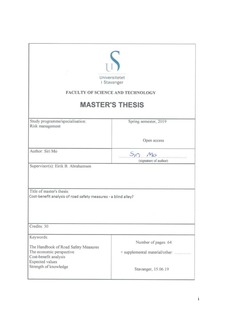| dc.description.abstract | As the Norwegian public road industry is characterized as a "low uncertainty" industry, especially in comparison to the Norwegian oil and gas industry, it has been common to give more weight to the economic perspective in decision-making processes in road safety work. The use of cost-benefit analyses in particular, which in its earliest form was created and used to ascertain how much society is willing to pay in order to gain a certain benefit, is still prevalent in present day priority setting and policy development in road safety. Such practices are justified by reference to portfolio theory, a strictly economic strategy of calculating project worth. Which road safety measures are chosen for implementation depends to a large extent on how large the expected benefits associated with the implementation are, compared to how much the implementation is expected to cost. A problem that arises with this strategy is that expected values are subject to uncertainty and variation, associated with the assumptions and knowledge of the analyst that performs the calculation. Issues may arise if road safety measures are ranked solely based on these assessments of expected values, with no consideration to the strength of knowledge used to calculate them.
The Handbook of Road Safety Measures by (Elvik, Vaa, Hoye, & Sorensen, 2009) features a collection of 128 different road safety measures, each assessed with respect to costs and benefits related to the effect of their implementation. Although the authors of the book claim that its contents are not designed for direct use in road safety policy making or decisions on how to prioritize between different safety measures, cost-benefit analyses such as those presented in the book lie at the core of actual policy making in the Norwegian Public Road Administration (NPRA). This thesis suggests that with the addition of some considerations on the uncertainty inherent in the calculations of the cost-benefit analyses, which are based on expected values and subjective assessments, the authors are able to present deeper and more insightful results than those found in the current edition of their work. An illustrative example which illustrates the benefits of such considerations based on assessments found in The Handbook of Road Safety Measures (Elvik et al., 2009) is presented. How uncertainty considerations may be included in future editions of the book is discussed. | nb_NO |
